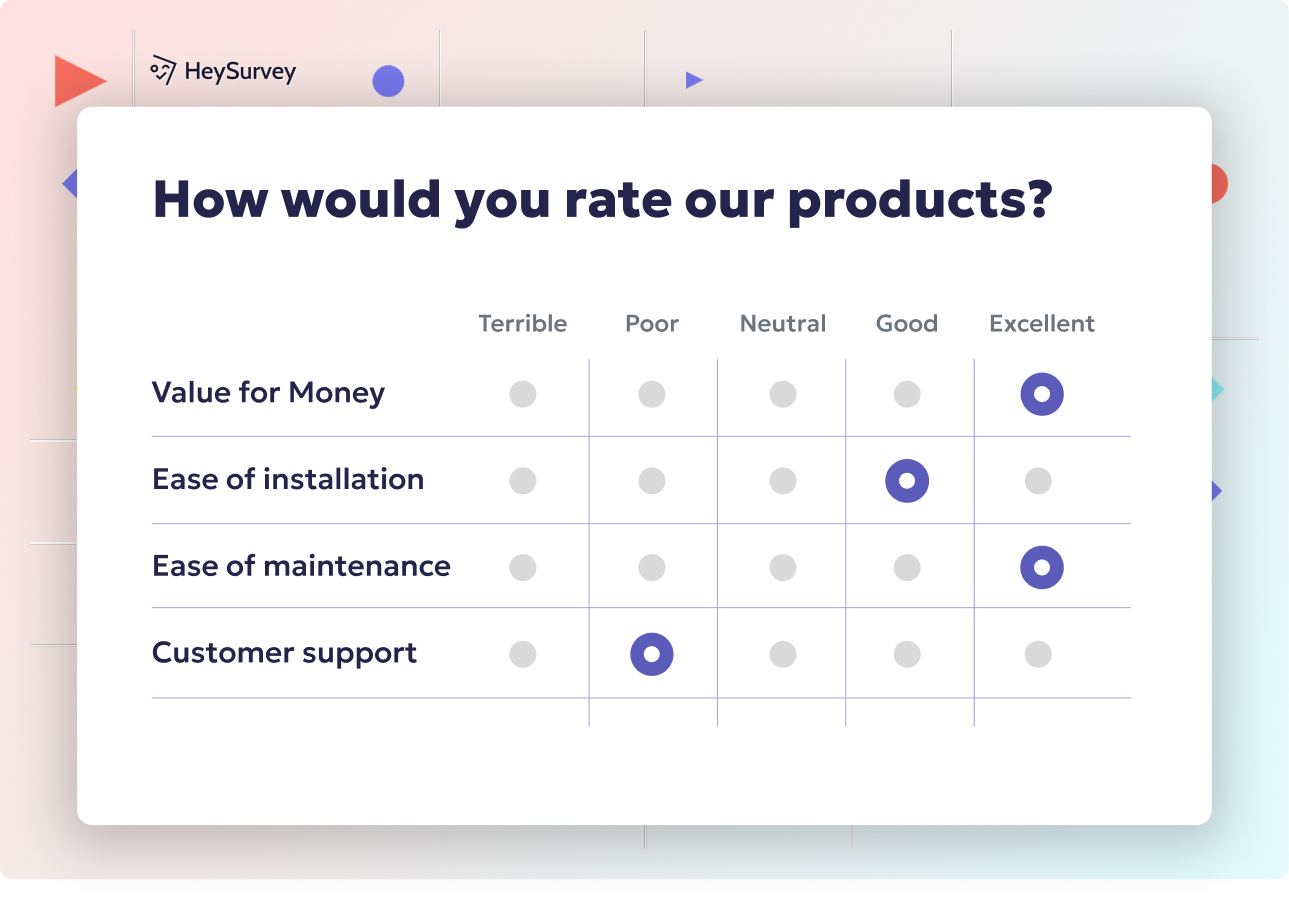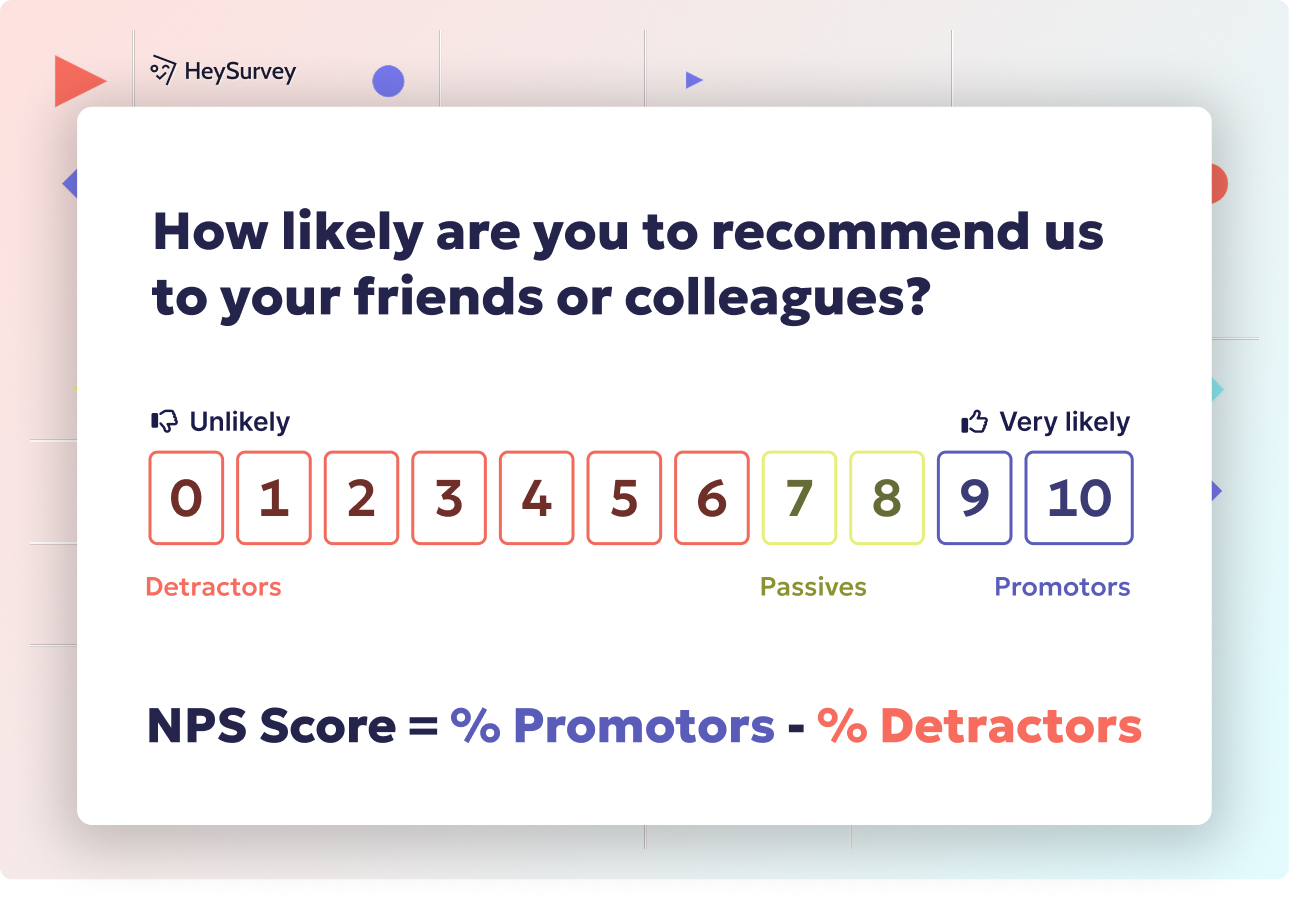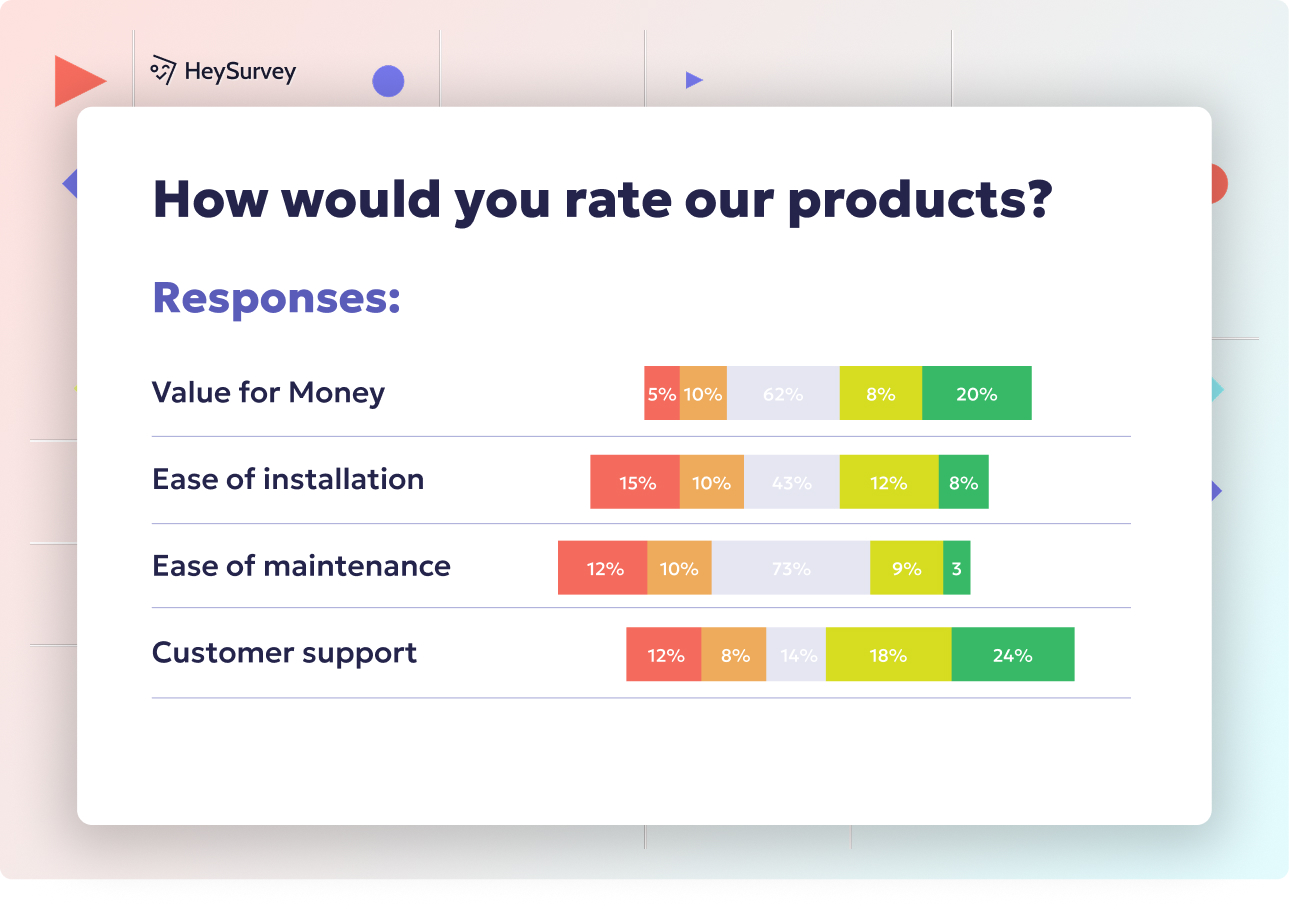30 Customer Loyalty Survey Questions to Boost Retention
Discover 40+ expert customer loyalty survey questions across 8 survey types that reveal what drives repeat purchases and boosts lifetime value.
Customer loyalty isn’t just a warm, fuzzy feeling—it’s the fuel that keeps brands thriving. When customers stick around, their repeat purchases stack up and their lifetime value climbs. Well-crafted surveys can unlock secrets behind loyalty and spot churn before it sneaks up on you. From classic NPS to rewards feedback and brand love, we’ll walk through eight powerful survey types—and show how each fits the arc of your customer’s journey.
Net Promoter Score (NPS) Survey
Why and When to Use This Survey Type
Net Promoter Score (NPS) surveys act as a thermometer for customer advocacy. They are quick to use and can tell you how likely your customers will shout your name from the rooftops. This makes it perfect for understanding not just satisfaction, but the magic of word-of-mouth.
NPS surveys shine brightest when you want a pulse check, not a full checkup. The best times to send them are:
- Quarterly, to track shifting loyalty.
- After onboarding, so you know if those first impressions wowed—or wobbled.
- Post-milestone moments, like hitting an anniversary or after an important update.
Remember, an NPS score isn’t just a number; it’s a clue about how much love (or grumbling) your brand inspires. Even a single comment here can transform your next move.
Five Sample NPS-Focused Questions
- On a scale of 0–10, how likely are you to recommend us to a friend or colleague?
- What is the primary reason for your score?
- What could we improve to earn a higher score from you?
- Which feature or benefit influenced your rating the most?
- Have you shared your experience with anyone in the past 30 days?
The secret to NPS is in the “why”—open up the floor for frank feedback so you can boost loyalty and stamp out churners before they vanish.
A study found that 81% of Net Promoter Score (NPS) promoters are very likely to repurchase from the company, compared to only 16% of detractors. (prnewswire.com)

Creating your customer loyalty survey with HeySurvey is easy-peasy! Here’s a quick 3-step guide to get you from zero to survey hero — plus some bonus tricks to make your survey truly shine.
Step 1: Create a New Survey
- Head to HeySurvey and start by creating a new survey.
- You can either pick an Empty Sheet to build from scratch or grab one of the handy pre-built templates to save time.
- Once picked, your survey will open up in the Survey Editor, ready for customization.
(When you’re ready, hit the button below this guide to open a ready-made template and jump right in!)
Step 2: Add Your Questions
- Click the Add Question button at the top or between existing questions.
- Choose question types like Scale for NPS or CES, Choice for multiple-choice questions, or Text if you want open-ended feedback.
- Enter your question text, tweak wording, and decide if you want them to be required.
- Use the settings to add options like “Other,” reorder answers, or set branching paths for more personalized flows.
Step 3: Publish Your Survey
- When your questions sing with perfection, click Preview to see how it looks on desktop and mobile.
- Make any last-minute style tweaks from the Designer Sidebar—colors, fonts, layouts, the works!
- Hit the Publish button, sign up or log in if needed, and voilà: your survey link is ready to share.
Bonus Step: Apply Your Branding
- Upload your logo in the Branding section so your survey feels like part of your brand family.
- Customize colors, fonts, and backgrounds using the Designer Sidebar for a survey as stylish as your business.
Bonus Step: Define Settings
- Tweak availability by setting start/end dates or response limits to control when and how many can respond.
- Set a redirect URL for after they submit, like a thank-you page or special offer.
Bonus Step: Branch Into Smarter Surveys
- Use branching to tailor the questions based on answers—serve relevant questions and skip the fluff.
- Define multiple endings to give personalized thank-you messages or promotions depending on how someone answers.
With these steps, you’re all set to launch surveys that actually capture the juicy feedback you need. Ready? Go ahead and create your first loyalty survey on HeySurvey now!
Customer Satisfaction (CSAT) Survey
Why and When to Use This Survey Type
The Customer Satisfaction (CSAT) survey isn’t about the big picture—it’s a magnifying glass on moments that matter. Think of it as a post-game interview right after a support call, delivery, or product tweak. These snapshots help you fix wobbles before they trip up loyalty.
CSAT surveys are your first line of defense against little friction points that become loyalty destroyers. Prime occasions to use CSAT include:
- After a customer support conversation.
- Immediately following a purchase or delivery.
- When you’ve made a process change that might impact experience.
The joy of CSAT? It’s short, punchy, and focused—you’ll find out if customers are satisfied before they quietly slip away.
Five Sample CSAT Questions
- How satisfied were you with your recent purchase experience?
- Did our product meet your expectations today?
- How well did our support team resolve your issue?
- Rate your satisfaction with the speed of service you received.
- How likely are you to make another purchase based on this experience?
When you measure these pivotal moments, you’re not just gathering feedback. You’re quietly building bridges to keep customers coming back, one satisfying experience at a time.
Effective customer satisfaction surveys balance quantitative and qualitative questions to capture comprehensive feedback, enhancing response rates and data reliability. (qualaroo.com)
Customer Effort Score (CES) Survey
Why and When to Use This Survey Type
No one likes a wild goose chase—especially your customers. Customer Effort Score (CES) surveys are your tool for smoothing the path to loyalty. The easier you make things, the more they’ll come back (and rave to their friends).
Use CES surveys right when effort matters most:
- Immediately after a task—like a support ticket or product return.
- When a new feature launches that changes how customers interact.
- Anywhere a “frictionless” experience is your end goal.
A high effort score can reveal hidden headaches that NPS or CSAT might miss. In business, sweat isn’t always a virtue!
Five Sample CES Questions
- How easy was it to resolve your issue today?
- The company made it simple for me to complete my purchase—agree or disagree?
- How many steps did you have to take to reach your goal?
- Rate the clarity of our self-service resources.
- What could we remove or simplify to make the process easier?
These questions get to the heart of friction, so you can remove obstacles and show your customers you care about their time—and sanity.
Post-Purchase Follow-Up Loyalty Survey
Why and When to Use This Survey Type
Right after a customer opens their shiny new purchase is the sweet spot for feedback. The post-purchase survey is all about capturing that fresh excitement (or disappointment). What you learn here can predict whether someone’s a one-time buyer or your next brand fan.
Timing is everything—send your survey:
- Three to seven days after the product lands or the service wraps up.
- When you want to check for buyer’s remorse or delight.
- Before memories fade and details blur.
These surveys help you fine-tune not just what you sell, but how it’s delivered, unboxing and all.
Five Sample Post-Purchase Questions
- How satisfied are you with your new product so far?
- What was the main factor that convinced you to buy from us?
- How likely are you to purchase from us again in the next six months?
- Did our product arrive in the condition you expected?
- What additional products or features would interest you?
Shining a light on the post-purchase experience lets you zero in on loyalty’s early warning signs—and pounce on new opportunities to wow.
Repeatedly soliciting customer feedback through post-purchase surveys may have detrimental cumulative effects on purchase behavior, including reduced purchase amounts and longer interpurchase times. (journals.sagepub.com)
Churn Risk (At-Risk Customer) Survey
Why and When to Use This Survey Type
Every business dreads the silent exit. Churn risk surveys are like listening devices on the exit door—they help you understand why customers drift away and what it takes to win them back. Getting ahead of churn means more repeat revenue—and less time spent hunting for replacements.
Deploy these surveys when:
- A customer’s usage dips or goes dormant.
- They downgrade, pause, or threaten to cancel.
- Your metrics scream “unhappy camper.”
No need to guess why churn happens—these questions get straight to the heart of it.
Five Sample Churn-Risk Questions
- We noticed you haven’t logged in lately—what’s the biggest reason?
- What would motivate you to use our product more often?
- Are you considering alternatives? If yes, which ones?
- How well does our pricing match the value you receive?
- What single improvement would keep you as a customer?
Armed with this knowledge, you can reverse-engineer departures and turn at-risk customers into comeback stories.
Brand Affinity & Advocacy Survey
Why and When to Use This Survey Type
Brand loyalty runs deeper than simple satisfaction. Brand affinity surveys explore the emotional glue that binds customers to your brand, turning fans into lifelong advocates. This is the part of the journey where transactional loyalty hands off to emotional connection.
Deploy these surveys:
- During annual brand health reviews.
- After major campaigns or brand pivots.
- When you want to measure the power of belonging.
It’s not just about what you sell, but what you stand for—and how well that resonates with your tribe.
Five Sample Brand Affinity Questions
- Which three words best describe our brand?
- How strongly do you feel aligned with our brand values?
- How proud are you to be associated with our brand?
- Does our brand’s mission resonate with your personal goals?
- Which competitors, if any, feel closer to your identity?
By uncovering what makes your brand lovable (or forgettable), you’ll know just where to invest your next big branding push.
Rewards Program Feedback Survey
Why and When to Use This Survey Type
Loyalty programs are the icing on the cake—but only if your customers find them tasty. Rewards program feedback surveys help you fine-tune perks so they’re irresistible (and profitable). If you’re offering rewards, make sure they spark joy, not confusion.
Prompt your customers right after:
- They redeem points.
- They hit new tiers or gain perks.
- They interact with rewards content or communications.
It’s a chance to learn what dazzles and what disappoints—before customers burn out or defect.
Five Sample Rewards Program Questions
- How valuable are the rewards you receive for your purchases?
- Which reward tier benefit excites you the most?
- How easy is it to understand how points are earned and used?
- What new perks would you like to see in the program?
- How likely are you to recommend our loyalty program to others?
These questions turn your loyalty program from a simple perk into a powerful engine for engagement and advocacy.
Referral Potential Survey
Why and When to Use This Survey Type
To grow quickly, you need champions—people who rave about you to their friends. Referral potential surveys help spot your potential ambassadors and kick off referral programs that actually convert. The trick is timing: reach out after high points, not low ones.
Win referral insights:
- Right after positive support or special achievements.
- When feedback signals strong satisfaction.
- During customer milestones that boost emotional investment.
Don’t guess who your advocates are—ask and empower them to spread the word.
Five Sample Referral Potential Questions
- Have you referred our product to someone in the past three months?
- What incentive would motivate you to refer us more often?
- Which type of customer do you think benefits most from our service?
- How comfortable would you feel sharing our brand on social media?
- What resource (e.g., templates, discounts) would help you make referrals?
With these answers, you can build a referral machine that’s powered by authentic enthusiasm and creative incentives.
Best Practices: Dos and Don’ts for Crafting Loyalty Survey Questions
Crafting loyalty surveys is just as important as the questions you ask. Make your surveys a joy to take and you’ll get richer, more reliable feedback. Here’s how to keep things snappy and insightful:
- Do keep surveys short and mobile-friendly.
- Make every word count—fewer questions mean more completed surveys.
Tap, not type, is your friend.
Don’t overload with mandatory open-ended fields.
Open text is gold, but don’t make it the entry fee for every question.
One or two comment boxes are enough.
Do personalize and time surveys contextually.
Reference the customer’s history, recent purchases, or milestones.
Match questions to the specific touchpoint.
Don’t send the same template to every segment.
Tailor for different customer journeys or product lines.
Segment by behavior or loyalty status.
Do A/B test wording and scales.
Try different phrasing for clarity and honesty.
Optimize number ranges, star ratings, or visual sliders.
Don’t change metrics mid-tracking cycle.
Consistency means you can spot real trends.
Only pivot between cycles or years—not in the middle.
Do close the feedback loop with thank-yous and improvements.
Send a friendly “thank you” or update on how you’re acting on feedback.
Customers notice when their input matters.
Don’t let responses vanish into a black hole.
Take quick visible action, especially for urgent complaints.
Do comply with data privacy regulations (GDPR, CCPA).
Protect data with transparency and care.
Clear opt-ins help build trust.
Don’t request unnecessary personal data.
Collect only what you need.
Less is more (and builds loyalty, too).
When you master these best practices, your surveys become a loop of learning, improving, and deepening the customer connection.
Building loyalty is both an art and a science. With the right survey at the right time, you unlock honest feedback—and real opportunities to wow your customers. Every answer is a puzzle piece in loyalty’s big picture. Done thoughtfully, loyalty surveys do more than predict churn or measure satisfaction; they set the stage for lasting relationships and advocacy. Now, go forth and get curious!
Related Customer Survey Surveys
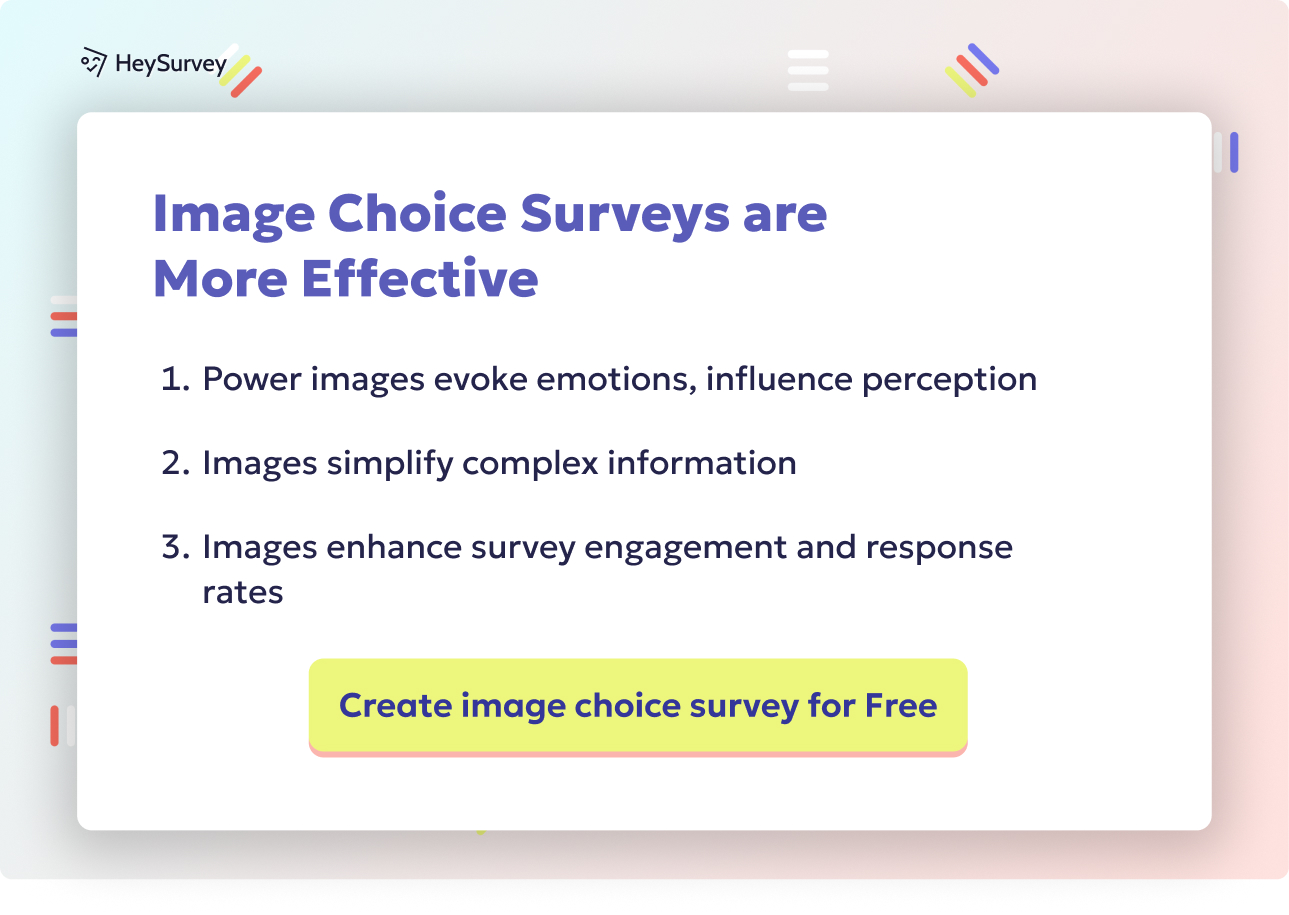
28 Restaurant Survey Questions to Boost Guest Satisfaction
Discover 28 insightful restaurant survey questions to improve guest experience, boost loyalty, an...
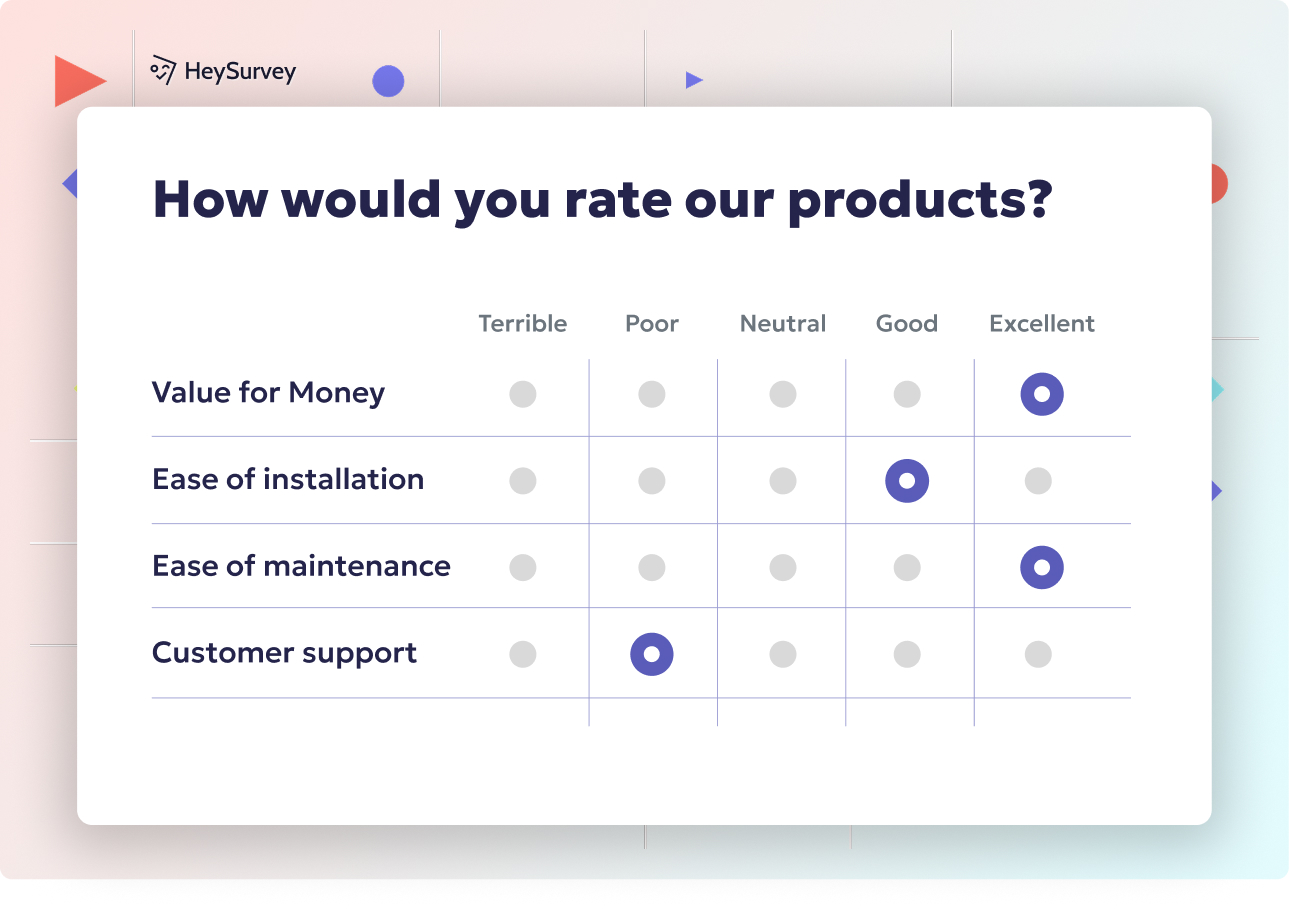
31 Interior Design Survey Questions: Types, Use & Examples
Discover 28 expert interior design survey questions covering preferences, style, budget, and more...
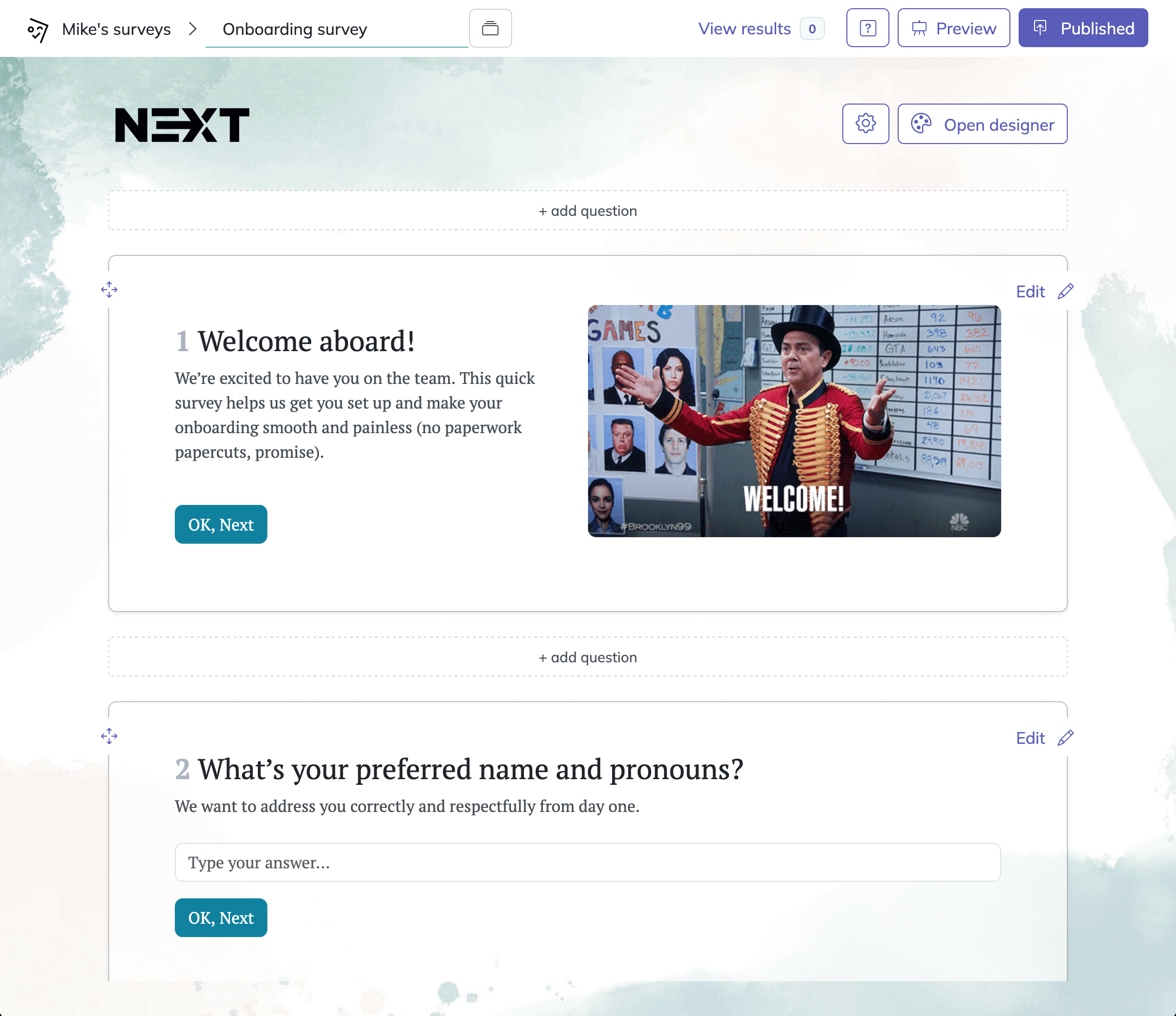
31 Essential Help Desk Survey Questions to Boost Support Success
Discover 30+ effective help desk survey questions with detailed examples to boost IT support feed...
